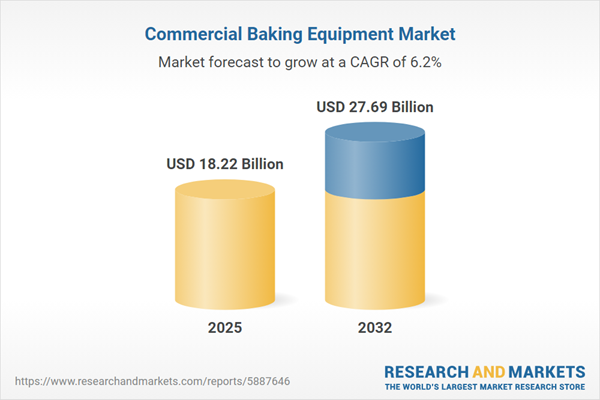Speak directly to the analyst to clarify any post sales queries you may have.
The commercial baking equipment market is undergoing rapid transformation, with industry leaders adapting to automation, digital integration, and evolving consumer demands for both artisanal and high-volume products. Designed for senior executives, this report provides actionable insights into technological developments, operational shifts, and broad market opportunities that impact procurement, strategy, and long-term business growth.
Market Snapshot: Commercial Baking Equipment Market Overview
The commercial baking equipment market grew from USD 17.16 billion in 2024 to USD 18.22 billion in 2025 and is projected to continue expanding at a CAGR of 6.16%, reaching USD 27.69 billion by 2032. Rising demand for advanced automation, smart systems, and compliance with global safety standards drives the adoption of more sophisticated solutions across global bakery and food manufacturing environments. Strategic investments in connected equipment and sustainability features play a crucial role as businesses focus on efficiency, productivity, and regulatory adaptation.
Scope & Segmentation
This report examines the commercial baking equipment market across comprehensive segmentation and global geographies, highlighting application diversity and technology convergence in the sector.
- Equipment Types: Mixers (planetary, spiral large capacity, spiral small capacity, vertical), ovens (convection electric, convection gas, deck, rotary rack, tunnel), proofers (rack automatic humidity control, rack manual control, retarder, static), slicers (automatic serrated blade, automatic steel blade, manual handheld).
- Applications: Biscuits and cookies (bars, cookies, crackers), bread (multigrain, white, whole wheat), cakes and pastries (cakes, cupcakes, pastries), snacks (chips, pretzels).
- End Users: Foodservice and hospitality (full service, institutional, quick service), industrial bakeries, retail bakeries.
- Operation Modes: Automatic (IoT enabled, non IoT), manual (hand operated), semi-automatic (electric, mechanical).
- Regions: Americas (North America—United States, Canada, Mexico; Latin America—Brazil, Argentina, Chile, Colombia, Peru), Europe, Middle East & Africa (UK, Germany, France, Russia, Italy, Spain, Netherlands, Sweden, Poland, Switzerland, UAE, Saudi Arabia, Qatar, Turkey, Israel, South Africa, Nigeria, Egypt, Kenya), Asia-Pacific (China, India, Japan, Australia, South Korea, Indonesia, Thailand, Malaysia, Singapore, Taiwan).
- Leading Companies: AMF Bakery Systems, Rademaker B.V., WP Bakery Group, Probat-Werke, Fritsch, Wachtel, Sancassiano, Diosna, Bühler AG, VMI Group.
Key Takeaways for Senior Decision-Makers
- Digital connectivity and automation are critical for streamlining operations and enhancing predictive maintenance, supporting both high-volume and specialty production lines.
- Flexible, modular equipment and cloud-based inventory integration provide agility for bakeries to explore small-batch offerings alongside scaled outputs, matching dynamic consumer preferences.
- Manufacturers actively collaborate with technology partners and foodservice operators to co-develop customized solutions that address application-specific requirements and operational efficiency.
- Environmental considerations fuel adoption of energy-efficient ovens and IoT-enabled proofers, helping operations align with increasingly stringent carbon and safety standards.
- Regional factors such as regulatory compliance, infrastructure maturity, and consumer trends strongly influence equipment selection and innovation priorities among global stakeholders.
Tariff Impact: Navigating Cost Pressures and Supply Chain Resilience
With the 2025 United States tariffs on key component imports, stakeholders are reexamining procurement strategies and negotiating flexible contracts. These levies have prompted a mix of nearshoring, alternative sourcing, and collaborative supply chain arrangements as companies aim to maintain competitiveness and mitigate disruptions. Engaging with trade associations and advocating for targeted tariff exemptions have also become essential for balancing protectionist policies with the need for technological innovation.
Research Methodology & Data Sources
The insights in this report are based on an integrated research process, combining thorough secondary research with direct interviews of industry executives, engineers, and procurement experts. Quantitative data from targeted surveys were triangulated against multiple sources and validated through expert workshops, ensuring accuracy and capturing the full spectrum of market dynamics.
Why This Report Matters
- Provides a clear framework for planning equipment investments in line with automation, sustainability, and operational flexibility goals.
- Offers actionable segmentation for market entry, product development, and procurement strategies tailored to regional and application-specific needs.
- Equips executive leaders with insights on risk mitigation amid regulatory shifts such as tariffs, promoting resilient supply chains and future-ready business models.
Conclusion
The commercial baking equipment market is characterized by rapid innovation, regulatory adaptation, and evolving consumer trends. Strategic alignment across automation, sustainability, and supply chain resilience will define competitive advantage for industry leaders.
Additional Product Information:
- Purchase of this report includes 1 year online access with quarterly updates.
- This report can be updated on request. Please contact our Customer Experience team using the Ask a Question widget on our website.
Table of Contents
3. Executive Summary
4. Market Overview
7. Cumulative Impact of Artificial Intelligence 2025
Companies Mentioned
The companies profiled in this Commercial Baking Equipment market report include:- AMF Bakery Systems, LLC
- Rademaker B.V.
- WP Bakery Group B.V.
- Probat-Werke von Gimborn Maschinenfabrik GmbH
- Fritsch GmbH & Co. KG
- Wachtel GmbH
- Sancassiano S.p.A.
- Diosna Dierks & Söhne GmbH
- Bühler AG
- VMI Group B.V.
Table Information
| Report Attribute | Details |
|---|---|
| No. of Pages | 190 |
| Published | November 2025 |
| Forecast Period | 2025 - 2032 |
| Estimated Market Value ( USD | $ 18.22 Billion |
| Forecasted Market Value ( USD | $ 27.69 Billion |
| Compound Annual Growth Rate | 6.1% |
| Regions Covered | Global |
| No. of Companies Mentioned | 11 |









